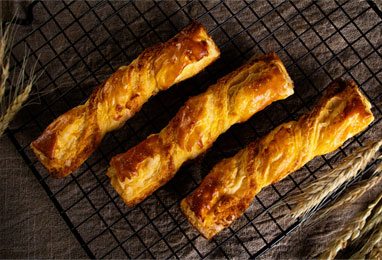Characteristics and Application of Isomaltooligosaccharide
Features and Applications
In recent years, sugar control, fat reduction, and healthy living have become important ingredient trends in baked pastries. Sucrose-free and natural sweeteners are gaining increasing attention, as consumers pursue healthier sweetness.
However, compared with other foods, sugar provides multiple functions in baking besides sweetness. Therefore, it is very difficult for baked goods to maintain their original texture and flavor while reducing sugar.
The current method of replacing sucrose mainly adopts the combination of strong sweeteners and low-sweetness bulking sweeteners or bulking agents, such as oligosaccharides and sugar alcohols.
The following mainly introduces the characteristics, functions and applications of isomaltooligosaccharide.
#1 Isomaltooligosaccharide
Isomaltooligosaccharide (IMO), also known as branched oligosaccharide, etc., is a type of starch sugar. Its main components are isomaltose, panose, isomaltotriose and oligosaccharides above tetrasaccharides, which are linked by α-1,6 glycosidic bonds between glucose molecules. The content of IMO reflects the quality of the product and also affects the price and application prospects of the product.
Isomaltooligosaccharide belongs to the category of non-digestible oligosaccharides, which has the function of water-soluble dietary fiber and is also a functional oligosaccharide.
Oligosaccharides are not digested by human digestive juices. Isomaltooligosaccharides can effectively promote the growth and reproduction of beneficial bacteria in the human body - Bifidobacterium, so it is also called "Bifidobacterium Growth Promotion Factor", or "Bifidobacterium Factor" for short. Many years of clinical and practical applications have shown that Bifidobacterium has many health functions.
#2 The characteristics and properties of isomaltooligosaccharide are as follows:
Sweetness
Taking the sweetness of white sugar as 100, the sweetness of oligosaccharide syrup IMO-50 is 52, and the sweetness of oligosaccharide syrup IMO-90 is 42. Isomaltooligosaccharide syrup (powder) has a good taste and can be used to replace part of sucrose to improve the taste of food and reduce the sweetness.
Viscosity
Its viscosity is very close to that of sucrose solution of the same concentration. It is easier to handle than maltose during food processing and has no adverse effect on the texture and properties of foods such as candy and cakes.
Heat and acid resistance
Isomaltooligosaccharide has excellent heat and acid resistance. A 50% syrup will not decompose if heated for a long time at pH 3 and 120°C.
Moisturizing
Isomaltooligosaccharide has moisturizing properties, making it difficult for water to evaporate. It has a good effect on moisturizing and maintaining the quality of various foods, and can inhibit the formation of crystals of sucrose and glucose. Foods based on starch, such as bread and desserts, often harden after a short storage. Adding isomaltose can prevent starch aging and extend the shelf life of food.
Colorability
The sugar molecule ends of isomaltooligosaccharide are reducing genes. When heated with proteins or amino acids, Maillard reaction will occur to produce color change. The depth of coloration is related to the sugar concentration, the type of protein or amino acid heated together, pH, heating temperature and heating time. Therefore, when using isomaltooligosaccharide to process various foods, the above factors should be considered.
Fermentability
Isomaltooligosaccharide is a sugar that cannot be used by yeast and lactic acid bacteria. When added to bread and fermented milk (yogurt), it will not be used by yeast and lactic acid bacteria but will remain in the food to exert its properties and promote the development of bifidobacteria.
Water activity
The water activity is 0.75 at a concentration of 75% and 25°C. Its water activity is smaller than that of sucrose, but close to that of sucrose, so it is more convenient to use it to replace part of sucrose in food formulas.
Inhibit starch aging
Isomaltooligosaccharide can prevent starch food from aging. When used in cakes and bread, it can keep these foods from hardening after long-term storage. Different amounts of isomaltooligosaccharide added can inhibit starch aging to varying degrees.
#3 Origin and production of isomaltooligosaccharide
Isomaltooligosaccharides rarely exist in a free state in nature, but as a component of branched starch or polysaccharides, they exist in small amounts in certain fermented foods such as soy sauce, rice wine or enzymatic glucose syrup.
The main raw material for the production of isomaltooligosaccharide is corn starch. The industrial production of isomaltooligosaccharide generally uses starch as raw material and adopts a full enzyme process. The technology is most mature in Japan. The main process is to use high-concentration glucose syrup made from starch as a substrate, and form isomaltose, isomaltotriose, isomaltotetraose, isomaltopentose and panose through the action of α-glucosidase.
Its production cost is an important factor affecting the price of isomaltooligosaccharide. The isomaltooligosaccharide industry is relatively concentrated and is a technology-intensive industry.
At present, the main market participants in the world's isomaltooligosaccharide industry are Baolingbao Bio, Bailong Chuangyuan Biotechnology, Japan Food Chemical, Japan Showa and Bioneutra. The manufacturers are mainly concentrated in China and Japan.
In the consumer market, the United States, China and Europe are the main consumer regions due to the large demand for downstream applications. In 2018, these three regions accounted for 70.3% of the global total consumption.
Currently, the main isomaltooligosaccharide products on the market are IMO-50 and IMO-90, which are available in syrup and powdered sugar forms respectively.
According to GB 20881-2007, the content of isomaltooligosaccharides in IMO-50 must account for more than 50% of the total dry matter, of which isomaltose, panose and isomaltotriose (referred to as trisaccharides) account for more than 35% of the total dry matter; IMO-90 requires that the IMO content reach more than 90% and the trisaccharide content reach more than 45%.
#4 Application in baking
Due to its moisturizing, low sweetness, non-fermentable sugar and anti-aging properties, isomalt oligosaccharide is used in the bread and pastry industry to partially replace sucrose, which can make pastries soft and crisp, bread elastic, sweet and delicious, not easy to age, extend the shelf life, improve the quality grade, and long-term consumption can improve intestinal function.
When isomaltooligosaccharide is used to replace 50% of the white sugar, the volume is about 5% larger than that of sucrose alone, and the texture becomes softer. The overall evaluation of taste and sweetness is better than that of white sugar alone.
Isomaltooligosaccharide can increase the viscosity of the batter, reduce the specific gravity of the batter, make the pores of the cake fine and dense, and also has coloring properties, making the cake color better.
Replacing 30% of the white sugar with oligosaccharides has better caseinization than using only sucrose, and the stability of the raw materials is almost the same; the volume of the finished product is slightly larger than that using only sucrose, the softness is also better, and the color is significantly darker.
Replacing sucrose during processing can prevent sanding, caking, deterioration, and reduce sweetness. Long-term use of these foods is beneficial to health.
In summary, isomaltooligosaccharide has excellent physical and chemical properties and significant physiological functions, and is widely used in food, health products, medicine and feed industries. The isomaltooligosaccharide industry is also in an upward period, and global consumption will show a steady growth curve.
-
Inulin
-
Polydextrose
-
Resistant Dextrin
- Trehalose
- Resistant Dextrin(Soluble Corn Fiber)
- Resistant Dextrin(Soluble Corn Fiber)(Powder)
- Resistant Dextrin(Soluble Tapioca Fiber)(Powder)
- Resistant Dextrin(Soluble Tapioca Fiber)(Liquid)
- Resistant Maltodextrin Powder
- Resistant Maltodextrin Powder (Liquid)
- Organic Resistant Dextrin Powder (Corn Type) 70%
- Organic Resistant Dextrin Powder (Corn Type) 90%
- Organic Resistant Dextrin Powder (Tapioca Type) 70%
- Organic Resistant Dextrin Powder (Tapioca Type) 90%
- Organic Resistant Dextrin Syrup (Corn Type) 70%
- Organic Resistant Dextrin Syrup (Corn Type) 90%
- Organic Resistant Dextrin Syrup (Tapioca Type) 70%
- Organic Resistant Dextrin Syrup (Tapioca Type) 90%
- Organic Resistant Maltodextrin Powder (Corn Type) 70%
- Organic Resistant Maltodextrin Powder (Tapioca Type) 70%
- Organic Resistant Maltodextrin Syrup (Corn Type) 70%
- Organic Resistant Maltodextrin Syrup (Tapioca Type) 70%
- Organic Soluble Corn Fiber Powder 70%
- Organic Soluble Corn Fiber Powder 90%
- Organic Soluble Corn Fiber Syrup 70%
- Organic Soluble Corn Fiber Syrup 90%
- Organic Soluble Tapioca Fiber Powder 70%
- Organic Soluble Tapioca Fiber Powder 90%
- Organic Soluble Tapioca Fiber Syrup 70%
- Organic Soluble Tapioca Fiber Syrup 90%
- Resistant Dextrin Powder (Corn Type) 70%
- Resistant Dextrin Powder (Corn Type) 90%
- Resistant Dextrin Powder (Tapioca Type) 70%
- Resistant Dextrin Powder (Tapioca Type) 90%
- Resistant Dextrin Syrup (Corn Type) 70%
- Resistant Dextrin Syrup (Corn Type) 90%
- Resistant Dextrin Syrup (Tapioca Type) 70%
- Resistant Dextrin Syrup (Tapioca Type) 90%
- Resistant Maltodextrin Powder (Corn Type) 90%
- Resistant Maltodextrin Powder (Tapioca Type) 90%
- Resistant Maltodextrin Syrup (Corn Type) 90%
- Resistant Maltodextrin Syrup (Tapioca Type) 90%
- Soluble Corn Fiber Powder 70%
- Soluble Corn Fiber Powder 90%
- Soluble Corn Fiber Syrup 70%
- Soluble Corn Fiber Syrup 90%
- Soluble Tapioca Fiber Powder 70%
- Soluble Tapioca Fiber Powder 90%
- Soluble Tapioca Fiber Syrup 70%
- Soluble Tapioca Fiber Syrup 90%
-
Dioscorea Opposita Dietary Fiber
-
Wheat Dietary Fiber
-
Oat Dietary Fiber
-
Polydextrose Powder (Conventional Type)
-
Polydextrose Powder (Special Type)
-
Polydextrose Powder (Sugar Free Type)
-
Polydextrose Powder (Type II)
-
Polydextrose Powder (Type III)
-
Polydextrose Syrup (Conventional Type)
-
Polydextrose Syrup (Refined Type)
-
Polydextrose Syrup (Special Type)
-
Polydextrose Syrup (Standard Type)
-
Polydextrose Syrup (Sugar Free Type)
- Fructo Oligosaccharide
-
Malt Oligosaccharide
- Isomalto-oligosaccharide 900 Powder
- Isomalto-oligosaccharide 900 Powder(Corn)
- Isomalto-oligosaccharide 900 Powder(Tapioca)
- Isomalto-oligosaccharide 900 Syrup
- Isomalto-oligosaccharide 900 Syrup(Tapioca)
- Isomalto-oligosaccharide 900 Liquid (Corn)
- Isomalto-oligosaccharide 900 Liquid (DP3)
- Isomalto-oligosaccharide 900 Liquid (Tapioca)
- Isomalto-oligosaccharide 900 Powder (Corn)
- Isomalto-oligosaccharide 900 Powder (DP3)
- Isomalto-oligosaccharide 900 Powder (Tapioca)
- Organic Isomalto-oligosaccharide 900 Liquid (Corn)
- Organic Isomalto-oligosaccharide 900 Liquid (DP3)
- Organic Isomalto-oligosaccharide 900 Liquid (Tapioca)
- Organic Isomalto-oligosaccharide 900 Powder (Corn)
- Organic Isomalto-oligosaccharide 900 Powder (DP3)
- Organic Isomalto-oligosaccharide 900 Powder (Tapioca)
- Xylo-oligosaccharide
- Galacto-oligosaccharide
-
Mannan Oligosaccharide
-
Isomaltulose Powder
-
Saigao Stachyose






